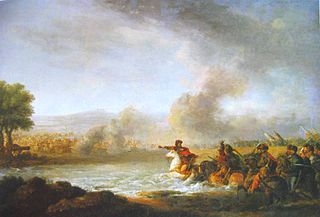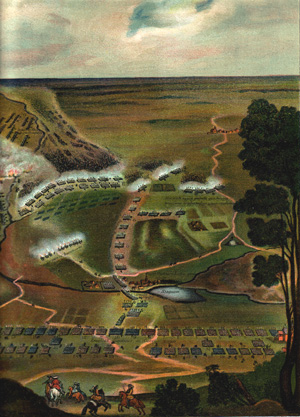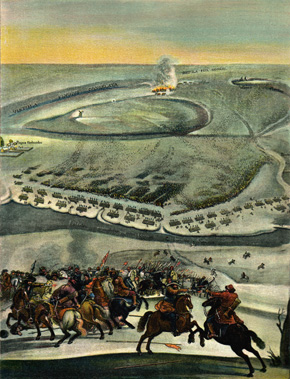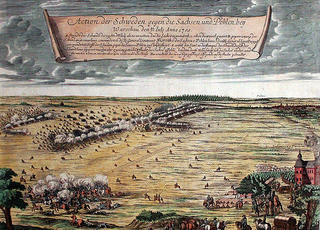
Charles X Gustav, also Carl Gustav, was King of Sweden from 1654 until his death. He was the son of John Casimir, Count Palatine of Zweibrücken-Kleeburg and Catherine of Sweden. After his father's death he also succeeded him as Pfalzgraf. He was married to Hedwig Eleonora of Holstein-Gottorp, who bore his son and successor, Charles XI. Charles X Gustav was the second Wittelsbach king of Sweden after the childless king Christopher of Bavaria (1441–1448) and he was the first king of the Swedish Caroline era, which had its peak during the end of the reign of his son, Charles XI. He led Sweden during the Second Northern War, enlarging the Swedish Empire. By his predecessor Christina, he was considered de facto Duke of Eyland (Öland), before ascending to the Swedish throne. From 1655 to 1657, he was also Grand Duke of Lithuania.

The Deluge was a series of mid-17th-century military campaigns in the Polish–Lithuanian Commonwealth. In a wider sense, it applies to the period between the Khmelnytsky Uprising of 1648 and the Truce of Andrusovo in 1667, comprising the Polish theatres of the Russo-Polish and Second Northern Wars. In a stricter sense, the term refers to the Swedish invasion and occupation of the Commonwealth as a theatre of the Second Northern War (1655–1660) only; in Poland and Lithuania this period is called the Swedish Deluge, or less commonly the Russo–Swedish Deluge due to the simultaneous Russo-Polish War. The term "deluge" was popularized by Henryk Sienkiewicz in his novel The Deluge (1886).

The Battle of Warsaw took place near Warsaw on July 28–July 30 [O.S. July 18–20] 1656, between the armies of the Polish–Lithuanian Commonwealth and Sweden and Brandenburg. It was a major battle in the Second Northern War between Poland and Sweden in the period 1655–1660, also known as The Deluge. According to Hajo Holborn, it marked "the beginning of Prussian military history".
The siege of Warsaw took place between April 24 and July 1, 1656. Swedish Empire forces had occupied the Polish capital without fighting in early September 1655. In late April 1656, Poles and Lithuanians began the siege, with the purpose of recapturing their capital. They were successful, but later lost the city for a second time after a battle held on July 28–30, 1656.

The Deluge is a historical novel by the Polish author Henryk Sienkiewicz, published in 1886. It is the second volume of a three-volume series known to Poles as "The Trilogy," having been preceded by With Fire and Sword and followed by Fire in the Steppe. The novel tells a story of a fictional Polish–Lithuanian Commonwealth soldier and noble Andrzej Kmicic and shows a panorama of the Commonwealth during its historical period of the Deluge, which was a part of the Northern Wars.
The Polish–Swedish War of 1626–1629 was the fourth stage in a series of conflicts between Sweden and Poland fought in the 17th century. It began in 1626 and ended four years later with the Truce of Altmark and later at Stuhmsdorf with the Treaty of Stuhmsdorf.

The Assault on Copenhagen also known as the Battle of Copenhagen on 11 February 1659 was a major engagement during the Second Northern War, taking place during the Swedish siege of Copenhagen.

The Battle of Warka occurred on April 7, 1656 between the forces of the Polish–Lithuanian Commonwealth, commanded by Stefan Czarniecki, and the forces of the Swedish Empire, commanded by Frederick VI, Margrave of Baden-Durlach. Lasting about two hours, the battle ended in a Polish victory.

The Battle of Nowy Dwór was fought during September 20 – September 30, 1655 between forces of the Polish–Lithuanian Commonwealth commanded by Jan Kazimierz Krasiński on one side, and on the other Swedish Empire forces commanded by Gustaf Otto Stenbock. It ended in Swedish victory.

The Battle of Kłecko was fought on May 7, 1656, between forces of the Polish–Lithuanian Commonwealth commanded by Regimentarz Stefan Czarniecki and Jerzy Sebastian Lubomirski and a Swedish force commanded by prince Adolf Johan av Pfalz-Zweibrücken. The Polish–Lithuanian force was more than 12,000 strong and consisted mostly of cavalry, while the Swedes numbered around 7,000 artillery, infantry and cavalry. The Swedes achieved a tactical victory in that they escaped destruction by the Poles, who were unable to get to the Swedish army entrenched behind the Welnianka River, and various ditches and swamps. Swedish army lost 428 dead, while the Polish army sustained 70 dead and wounded, 2,000 dead or 3,000 dead, including 40 companions dead.

The Battle of Gołąb was fought on either 18 or 19 February 1656, between forces of the Polish–Lithuanian Commonwealth commanded by Stefan Czarniecki on one side, and on the other Swedish Empire's army commanded by Charles X Gustav. This battle was essentially a meeting engagement with Swedish troops arriving on the battlefield at different times. It is uncertain how many actually participated, and its actual date is disputed. Some sources, such as Polish-language Military Encyclopedia, claim it took place on 18 February, while historian Leszek Podhorecki wrote that it was on 19 February. The outcome was a Swedish victory.

The Battle of Warsaw was fought on 31 July 1705 near Warsaw, Polish–Lithuanian Commonwealth, during the Great Northern War and Swedish invasion of Poland (1701–1706). The battle was part of a power struggle for the Polish–Lithuanian throne. It was fought between Augustus II the Strong and Stanisław Leszczyński and their allies. Augustus II entered the Northern war as elector of Saxony and king of the Polish–Lithuanian Commonwealth, and had formed an alliance with Denmark–Norway and Russia. Stanisław Leszczyński had seized the Polish throne in 1704, with the support of the Swedish army of Charles XII of Sweden. The struggle for the throne forced the Polish nobility to pick sides; the Warsaw Confederation supported Leszczyński and Sweden, and the Sandomierz Confederation supported Augustus II and his allies. The conflict resulted in the Polish civil war of 1704–1706.

The Battle of Nyborg took place between Sweden and the combined forces of Denmark, Dutch naval forces under Michiel de Ruyter, troops of Brandenburg-Prussia, and Polish–Lithuanian Commonwealth forces under Stefan Czarniecki. The battle was engaged on 14 November 1659 at Nyborg on the Danish island of Funen. Nyborg was the final major battle of the Dano-Swedish War of 1658 to 1660.
The Battle of Gniew or the Battle of Mewe was fought during the Polish–Swedish War (1626–1629), between Sweden and the Polish–Lithuanian Commonwealth from 22 September with initial skirmishes, to the main battle of 1 October 1626. Both the Swedish and Polish army were commanded by their kings – Gustavus Adolphus of Sweden and Sigismund III Vasa. The battle ended in indecisively. However, Polish and Swedish armies had different objectives. Sigismund Vasa wanted to protect Gdańsk from besieging. Gustav had to protect Gniew, which was important for the prestige of his army.
The Battle of Selburg was fought during the Polish–Swedish War (1626–1629), between Sweden and the Polish–Lithuanian Commonwealth in September 1626. The Polish forces under Aleksander Gosiewski managed to recapture Selburg from the Swedes earlier in 1626 and stationed their troops in the castle. In response the Swedish general Jacob De la Gardie gathered his force to once again capture the town for the Swedes.
The Battle of Jarosław took place during the Deluge on March 15, 1656. Polish-Lithuanian Commonwealth forces under the command of Stefan Czarniecki defeated the Swedish forces commanded by Charles X Gustav of Sweden.
The Battle of Nisko was one of battles of the Swedish invasion of Poland that took place on March 28, 1656. It resulted in a victory of Swedish forces, commanded by King Charles X Gustav.
The Battle of Kcynia took place on June 1, 1656, and was one of battles of the Swedish invasion of Poland. It resulted in a victory of Swedish forces, commanded by King Charles X Gustav and Adolph John I, Count Palatine of Kleeburg.

The Campaign of Grodno was a plan developed by Johann Patkul and Otto Arnold von Paykull during the Swedish invasion of the Polish–Lithuanian Commonwealth, a part of the Great Northern War. Its purpose was to crush Charles XII's army with overwhelming force in a combined offensive of Russian and Saxon troops. The campaign, executed by Peter I of Russia and Augustus II of Saxony, began in July 1705 and lasted almost a year. In divided areas the allies would jointly strike the Swedish troops occupied in Poland, in order to neutralize the influence the Swedes had in the Polish politics. However, the Swedish forces under Charles XII successfully outmaneuvered the allies, installed a Polish king in favor of their own and finally won two decisive victories at Grodno and Fraustadt in 1706. This resulted in the Treaty of Altranstädt (1706) in which Augustus renounced his claims to the Polish throne, broke off his alliance with Russia, and established peace between Sweden and Saxony.

The Swedish invasion of Saxony took place in 1706 during the Great Northern War, which began in 1700 when Russia, Denmark–Norway, and Saxony attacked Sweden or its ally, Holstein-Gottorp. To force Augustus II the Strong out of the war, who was the elector of Saxony and king in the Polish–Lithuanian Commonwealth, Charles XII of Sweden invaded the Commonwealth; Augustus was dethroned in 1704, and, after a devastating Saxon defeat at Fraustadt, Charles XII marched against Saxony in 1706 with 20,000 men.













